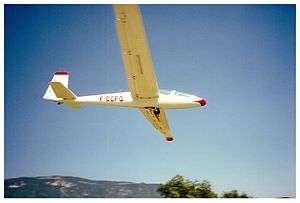Breguet Br 904 Nymphale
| Br 904 Nymphale | |
|---|---|
 | |
| Role | Two-seat sailplane |
| National origin | France |
| Manufacturer | Société des Ateliers d'Aviation Louis Breguet (Breguet Aviation) |
| Designer | R. Jarland |
| First flight | 26 May 1956 |
| Produced | 1956-9 |
| Number built | 18 |
| Developed from | Breguet Br 901 Mouette |
The Breguet Br 104 Nymphale (English: Nymph) is a two seat training and competition sailplane, built in France in the 1950s. A direct development of the successful Breguet Br 901 Mouette, it competed at two World Gliding Championships but has mostly been used, in small numbers, by gliding clubs.
Design and development
The Nymphale is a two-seat development of the double World Gliding Championships (WGC) winning Br 901 Mouette. It is larger all round, with a 2.72 m (8 ft 11 in) increase in span and 1.43 m (4 ft 8 in) longer, but is built of wood and fabric like the single-seater.[1] Behind the wings the 904 and the 901 S1 - the two seater has the more angular fin and rudder of the later 801s - are very much alike in appearance, with a tapering fuselage and conventional empennage. The mid mounted wings, though straight-tapered like those of the 901, differ in having no sweep on the leading edge so that at mid-chord the wing is forward-swept. The cockpit, necessarily lengthened, has the same style of fuselage contour following canopy as the 901 but is divided into front and rear sections, the latter stretching back over the wing leading edge.[2]
The Nymphale made its first flight on 26 May 1956;[1] two more prototypes followed.[3]
Operational history
Fifteen production series 904S Nymphales were built[3] in the late 1950s and widely used by gliding clubs.[4] The Nymphale also competed: one placed 5th in the two-seater class of the 1956 WGC held at Saint-Yan in France.[5] Two years later it again competed in the WGC, held at Leźno in Poland, this time in the Open class with one seat empty. With this disadvantage it could gain only 17th place.[6]
In 2010 six complete Nymphales were on the civil registers of European countries, all in France.[7]
Variants
Specifications
Data from Die Berühmtesten Segelflugzeuge[1]
General characteristics
- Crew: two
- Length: 9.0 m (29 ft 6 in)
- Wingspan: 20.04 m (65 ft 9 in)
- Wing area: 20.0 m2 (215 sq ft)
- Aspect ratio: 20
- Airfoil: NACA 63 series
- Empty weight: 340 kg (750 lb)
Performance
- Stall speed: 62 km/h (39 mph; 33 kn)
- Never exceed speed: 220 km/h (137 mph; 119 kn)
- Rough air speed max: 180 km/h (111.8 mph; 97.2 kn)
- Aerotow speed: 150 km/h (93.2 mph; 81.0 kn)
- Maximum glide ratio: 35:1
- Rate of sink: 0.70 m/s (138 ft/min)
- Lift-to-drag: at 70 km/h (43.5 mph; 37.8 kn)
- Wing loading: 34.5 kg/m2 (7.1 lb/sq ft)
References
| Wikimedia Commons has media related to Breguet aircraft. |
- 1 2 3 Brütting, Georg (1973). Die berümtesten Segelflugzeuge. Stuttgart: Motorbuch Verlag. p. 142. ISBN 3 87943171 X.
- ↑ "Breguet 904". Retrieved 22 April 2012.
- 1 2 3 4 "Breguet 904 production list". Retrieved 22 April 2012.
- ↑ Taylor, John W R (1960). Jane's All the World's Aircraft 1960-61. London: Sampson Low, Marston & Co. Ltd. p. 122.
- ↑ "World Gliding". Flight. Vol. 70 no. 2478. 20 July 1956. p. 123.
- ↑ "World Gliding Championships". Flight. Vol. 74 no. 2580. 4 July 1958. p. 12.
- ↑ Partington, Dave (2010). European registers handbook 2010. Air Britain (Historians) Ltd. p. 247. ISBN 978-0-85130-425-0.